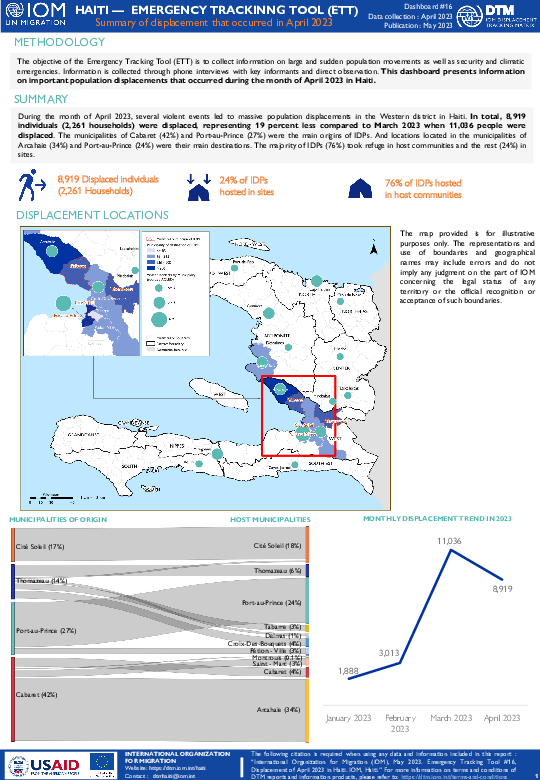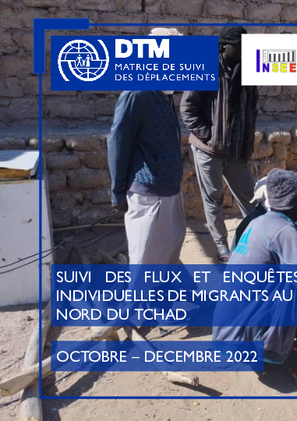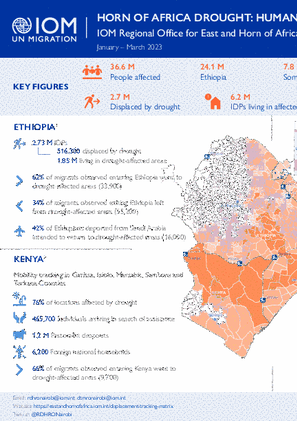-
Countries
-
Data and Analysis
-
Special Focus
-
Crisis Responses

Contact
DTM Support, DTMSupport@iom.int
Language
English
Location
Malawi
Period Covered
Mar 31 2023
Apr 27 2023
Activity
- Mobility Tracking
- Site Assessment
This report details the site profiles as determined by Multi-Sectoral Location Assessments (MSLA). A summary overview can be accessed here.
Cyclone Freddy made landfall in Malawi’s Southern Region on 12 March 2023, bringing torrential rainfall, and causing devasting floods and mudslides in Southern Malawi. Assessments are still ongoing, led by the Department of Disaster Management Affairs (DoDMA) but critical infrastructure (roads, houses and hospitals) have been damaged or destroyed. As of 20 March 2023, DoDMA estimates over 508,000 people have been displaced across Nsanje, Chikwawa, Phalombe, Mulanje, Blantyre, Thyolo, Chiradzulu, Blantyre City, Mangochi, Machinga and Balaka districts. An estimated 534 evacuation centers/Internally Displaced People (IDP) sites have been established with over 70 per cent of the IDPs being hosted in public buildings such as schools and churches. The Government of Malawi (GoM) announced a state of disaster in 14 districts on 13 March in response to the floods and landslides, and rescue teams were deployed to the affected areas to provide humanitarian assistance to those most affected. IOM deployed teams on 3 April to conduct a Multi-Sectoral Location Assessment (MSLA) at camp/collective sites level to assist the Government and partners with their response efforts. The first update of the report covers the 168 sites assessed from 31 March - 27 April and provides a snapshot of the current number of displaced households and persons residing in the worst affected three districts (Nsanje, Chikwawa and Blantyre). The assessments also provide an overview of the types of IDP sites, NFI needs, intentions, services provided and other key information.

Contact
DTM Nigeria, iomnigeriadtm@iom.int
Language
English
Location
Nigeria
Period Covered
Apr 01 2023
Apr 30 2023
Activity
- Event Tracking
As a component of the IOM's Displacement Tracking Matrix (DTM), the Transhumance Tracking Tools supported by a network of community key informants, collected information on events relating to herders and farmers conflicts. The triangulated alerts comprises of 137 (88%) events and 18 (12%) movement alerts across 31 wards in the 5 LGAs.
The largest number of alerts occurred in Demsa LGA (35%) followed by Lamurde LGA (28%), Numan LGA (13%), Mayo-belwa (13%) and Girei (11%). The disaggregated alerts show the highest reports were made in Kodompti (9%) and Demsa (8%) wards located respectively in Numan and Demsa LGAs. Approximately 2 per cent of events alerts resulted in population displacement, while 27 per cent lead to causality or injuries.

Contact
dtmhaiti@iom.int
Language
English
Location
Haiti
Period Covered
Apr 01 2023
Apr 30 2023
Activity
- Mobility Tracking
- Event Tracking
The objective of the Emergency Tracking Tool (ETT) is to collect information on large and sudden population movements as well as security and climatic emergencies. Information is collected through phone interviews with key informants and direct observation. This dashboard presents information on important population displacements that occurred during the month of April 2023 in Haiti.
During this month, several violent events led to massive population displacements in the Western district in Haiti. In total, 8,919 individuals (2,261 households) were displaced, representing 19 percent less compared to March 2023 when 11,036 people were displaced. The municipalities of Cabaret (42%) and Port-au-Prince (27%) were the main origins of IDPs. And locations located in the municipalities of Arcahaie (34%) and Port-au-Prince (24%) were their main destinations. The majority of IDPs (76%) took refuge in host communities and the rest (24%) in sites.

Contact
DTM Chad, dtmtchad@iom.int
Language
French
Location
Chad
Period Covered
Oct 01 2022
Dec 31 2022
Activity
- Survey
- Flow Monitoring Survey
- Flow Monitoring
Le suivi des flux de populations est un travail de collecte des données qui vise à identifier des zones sujettes aux migrations internes et transfrontalières et à mettre en lumière les caractéristiques et les parcours des personnes passant par ces zones. Il est mis en œuvre en étroite collaboration avec les autorités et des partenaires nationaux et locaux, à travers deux outils: l’enregistrement des flux (Flow Monitoring Registry, FMR) et les enquêtes individuelles (Flow Monitoring Survey, FMS).
L'outil récolte des données clés sur l’amplitude des flux migratoires, les profils des voyageurs ainsi que leurs parcours et intentions, afin de fournir une meilleure compréhension des flux migratoires dans la région et contribuer à l’élaboration des politiques migratoires basées sur des évidences.
À cet effet, plusieurs points de suivi des flux de population (Flow Monitoring Point, FMP) sont installés dans des zones de transit importantes. Durant le quatrième trimestre de 2022, avec l’implication de l’Institut National de la Statistique et des Etudes Economiques et Démographiques (INSEED), quatre FMP ont été actifs a Faya, Ounianga Kébir, Gouro et Zouarké, respectivement situés dans les provinces du Borkou, de l’Ennedi Ouest et du Tibesti, au nord du Tchad. Ce rapport présente les données clés collectées entre octobre et décembre 2022 au niveau de ces quatre FMP. Le rapport est subdivisé en deux sections:
-
Une section présentant les données obtenues lors de l’enregistrement des flux (FMR).
-
Une autre section présentant les résultats des enquêtes individuelles effectuées auprès des voyageurs (FMS).

Contact
DTM Tchad, dtmtchad@iom.int
Language
French
Location
Chad
Period Covered
Nov 29 2022
Jan 09 2023
Activity
- Mobility Tracking
- Site Assessment
- Baseline Assessment
Ce tableau de bord présente les résultats d'évaluations menées entre le 29 Novembre 2022 – 9 Janvier 2023 dans 245 lieux de déplacement. Une légère augmentation du nombre des personnes déplacées, a été observé durant ce round 19 par rapport au round précédent (+6%). Ceci s’explique principalement par les déplacements dus aux inondations et à l'insécurité durant cette période. C’est à noter que ces évaluations prennent en compte les chiffres issus des enregistrements biométriques menés par l’Institut national des statistiques et des études économiques et démographiques (INSEED), la Commission Nationale d’Accueil de Réinsertion des Réfugiés et des Rapatriées (CNARR), le Programme alimentaire mondial (PAM) et l’Organisation internationale pour les migrations (OIM), dans 11 localités en décembre 2022 et janvier 2023, qui a contribué à une baisse de 5 pour cent dans la sous-préfecture de Baga-Sola. Comme pour le round précédent de collecte de données, le round 19 a été réalisé en partenariat avec la CNARR et l’association pour l’Action Humanitaire et le Développement Durable (ACHDR), en appliquant une méthodologie de vérification ainsi que le renforcement de l'observation physique et de la sensibilisation des informateurs clés et les autorités administratifs pour éviter les doubles comptages ou la surestimation des informateurs clés.
Contact
DTM Sudan, DTMSudan@iom.int
Location
Sudan
Activity
- Mobility Tracking
- Baseline Assessment
Period Covered
Apr 15 2023 -May 12 2023
From 15 April 2023, armed clashes erupted between the Sudanese Army Forces (SAF) and the Rapid Support Forces (RSF) in multiple cities across Sudan, including Khartoum, Al Fasher, Kebkabiya, Merowe, Nyala, Ag Geneina, and El Obeid. DTM Sudan has been receiving reports of widespread displacement across different states in Sudan due to the ongoing security situation.
— Since 15 April 2023, DTM estimates that approximately 843,130 individuals (168,354 households) have been displaced internally as a result of the conflict.
— Notably, the current estimate for displacement since the conflict began is comparable to that recorded by DTM Sudan for all displacement during 2021 and 2022 combined.
—Furthermore, an estimated an additional 253,591 individuals have crossed into neighbouring countries.
Population Groups
Survey Methodology
Unit of Analysis Or Observation
Type of Survey or Assessment
Keywords
Geographical Scope
Administrative boundaries with available data
The current dataset covers the following administrative boundaries
This snapshot provides an overview of the impact of drought on human mobility in the region, with a focus on Djibouti, Ethiopia, Kenya and Somalia.
May 17 2023
Print
Global
No
Contact
DTM Ethiopia, SLOAddisAbabaDTM@iom.int
Location
Ethiopia
Activity
- Mobility Tracking
- Village Assessment
Period Covered
Nov 25 2022 -Jan 08 2023
The purpose of VAS is to assess the capacity of villages to absorb returns through the availability of services with a focus on livelihoods and reintegration. Demographic information was collected through representative sampling at the village level at a 95% confidence interval and a 10% margin of error. Overall, 1887154 IDP returnees and 424162 returnee households were identified.
Population Groups
Survey Methodology
Unit of Analysis Or Observation
Type of Survey or Assessment
Keywords
Geographical Scope
Administrative boundaries with available data
The current dataset covers the following administrative boundaries
